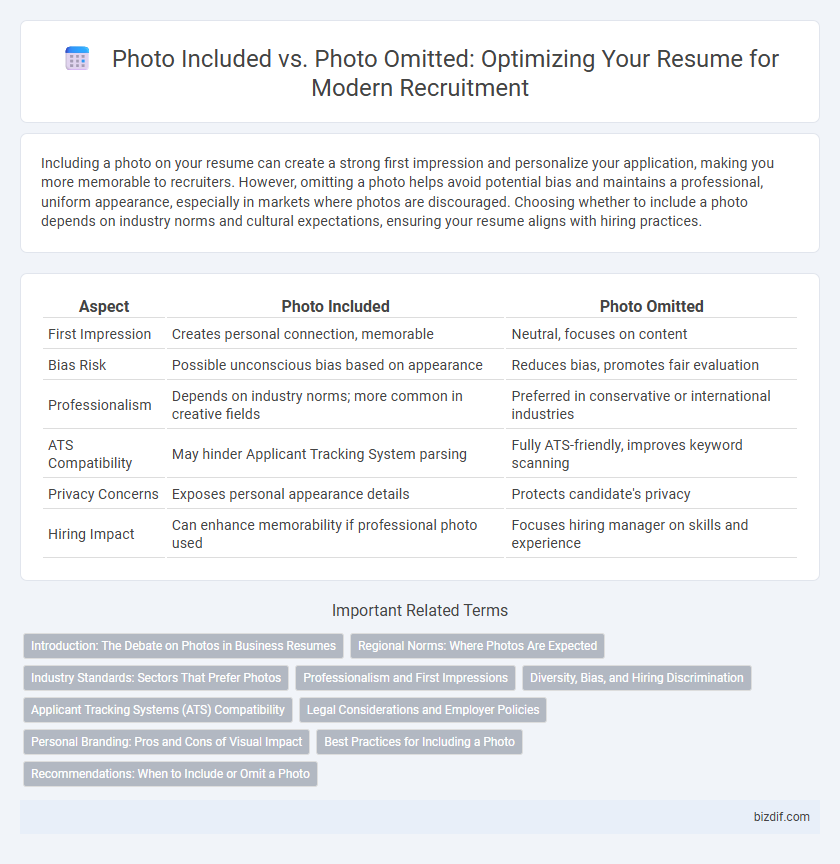Including a photo on your resume can create a strong first impression and personalize your application, making you more memorable to recruiters. However, omitting a photo helps avoid potential bias and maintains a professional, uniform appearance, especially in markets where photos are discouraged. Choosing whether to include a photo depends on industry norms and cultural expectations, ensuring your resume aligns with hiring practices.
Table of Comparison
| Aspect | Photo Included | Photo Omitted |
|---|---|---|
| First Impression | Creates personal connection, memorable | Neutral, focuses on content |
| Bias Risk | Possible unconscious bias based on appearance | Reduces bias, promotes fair evaluation |
| Professionalism | Depends on industry norms; more common in creative fields | Preferred in conservative or international industries |
| ATS Compatibility | May hinder Applicant Tracking System parsing | Fully ATS-friendly, improves keyword scanning |
| Privacy Concerns | Exposes personal appearance details | Protects candidate's privacy |
| Hiring Impact | Can enhance memorability if professional photo used | Focuses hiring manager on skills and experience |
Introduction: The Debate on Photos in Business Resumes
Including a photo on a business resume can create a memorable first impression and personalize the application, but it may also introduce unconscious bias during the hiring process. Omitting a photo ensures focus remains solely on skills, qualifications, and experience, promoting a fair and objective evaluation by recruiters. Understanding industry norms and regional practices is crucial when deciding whether to include or exclude a photo on a professional resume.
Regional Norms: Where Photos Are Expected
In regions like Europe, Asia, and parts of Latin America, including a professional photo on a resume is a common expectation, as it personalizes the application and aligns with local hiring practices. Conversely, in the United States, Canada, and the UK, omitting a photo is standard to prevent potential bias and comply with anti-discrimination laws. Understanding these regional norms ensures your resume meets employer expectations and improves your chances in the selection process.
Industry Standards: Sectors That Prefer Photos
In resume writing, industries such as modeling, acting, hospitality, and certain creative fields often prefer including a professional photo to enhance personal branding and visual appeal. Conversely, corporate sectors like finance, law, and technology typically omit photos to prioritize qualifications and reduce bias during the hiring process. Understanding sector-specific standards ensures resumes align with employer expectations and improve overall recruitment outcomes.
Professionalism and First Impressions
Including a professional photo on a resume can enhance first impressions by conveying confidence and approachability, particularly in client-facing industries or creative fields. However, omitting a photo is often recommended to maintain a focus on qualifications and avoid unconscious bias, ensuring professionalism in sectors prioritizing skills over appearance. Selecting whether to include a photo should align with industry standards and cultural expectations to optimize the resume's impact.
Diversity, Bias, and Hiring Discrimination
Including photos on resumes can unintentionally introduce bias, affecting diversity and hiring fairness as recruiters may form unconscious judgments based on appearance. Omitting photos helps promote an impartial evaluation focused solely on qualifications, skills, and experience, supporting inclusive hiring practices. Research indicates that photo omission reduces discrimination related to gender, ethnicity, and age, fostering equitable opportunities for all candidates.
Applicant Tracking Systems (ATS) Compatibility
Including a photo in a resume can hinder Applicant Tracking Systems (ATS) compatibility, as many ATS software struggle to accurately parse images, which may lead to errors or incomplete data extraction. Omitting a photo ensures the resume's text-based content is fully readable and searchable by ATS algorithms, increasing the chances of passing initial automated screenings. Most hiring professionals and ATS experts recommend excluding photos to maintain format integrity and optimize resume parsing efficiency.
Legal Considerations and Employer Policies
Including a photo on a resume can raise legal concerns related to discrimination laws under the Equal Employment Opportunity Commission (EEOC) guidelines, as visual information may inadvertently influence hiring decisions based on age, race, or gender. Many employers and recruitment platforms recommend omitting photos to comply with anti-discrimination policies and maintain fair hiring practices. Candidates should research specific employer policies and regional legal requirements before deciding to add a photo to their resume.
Personal Branding: Pros and Cons of Visual Impact
Including a photo on a resume enhances personal branding by creating a memorable visual connection with recruiters, emphasizing professionalism and approachability. However, omitting the photo can prevent unconscious biases related to age, ethnicity, or appearance, promoting a focus solely on skills and qualifications. Balancing visual impact with fairness, the decision depends on industry norms and the candidate's strategic branding goals.
Best Practices for Including a Photo
Including a professional photo on a resume can enhance personal branding and create a memorable first impression, especially in creative industries and client-facing roles. Optimal photos are high-quality, feature a neutral background, and present the candidate in business attire with a friendly, approachable expression. Avoid casual images or distracting backgrounds to maintain professionalism and align with the expectations of hiring managers and applicant tracking systems.
Recommendations: When to Include or Omit a Photo
Including a photo on a resume is recommended in creative industries such as modeling, acting, or design where visual presentation is relevant to the role. Omit the photo in traditional corporate sectors like finance, law, or technology to avoid unconscious bias and ensure focus on qualifications and experience. When applying internationally, research cultural norms and employer expectations to decide if a photo enhances or detracts from your candidacy.
Photo Included vs Photo Omitted Infographic

 bizdif.com
bizdif.com